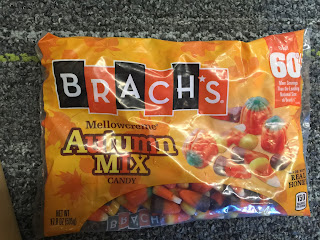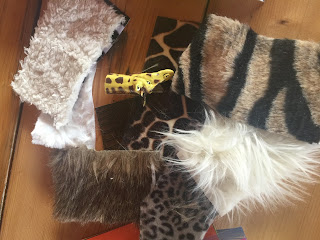
Happy fall y'all! I hope everyone's fall is off to a great start and you have your Halloween costume ready to go for next week. This school year I am putting together ECC kits about a variety of different topics. My first kit is for teaching the fall season. I thought I would share the materials and the lesson plan examples.
I bought my materials from Joann Fabrics and Walmart. Both places ended up being treasure hot spots for ideas. I wanted to find a way to teach about the fall season and not just the individual holidays of Halloween and Thanksgiving.
The fall kit materials allows more concrete objects to be used for instruction. I also combined core curriculum areas (math, social studies, science) and all Expanded Core areas. I also loved finding all the theme window clings because I can use them on light box. I found both Halloween and fall themed clings. It was a fun way to use the light box.
Here are some of the items included in my fall kit:
The autumn candy mix (used for counting, filling in a Braille cell template to make letters, your turn/my turn).
Small gourds and acorns:
A bale of hay:
I loved these cinnamon scented pine cones! They had the strongest scent. I bought these at Joann Fabrics.
I really wanted to provide a variety of ways to integrate the concept of fall in all ECC areas. I bought all kinds of spices such as cinnamon sticks, nutmeg and pumpkin extract to use in cooking activities, sensory activities and art activities.
I also just found some fun items like the cookie cutters. I used these with APH's The Littlest Pumpkin activities. I also used them for teaching big and little.
It was also important to me to include real items so I purchased Indian corn, the acorns, leaves, pumpkins and gourds. Leaves can be tricky because they can be delicate. I did find some pretty realistic artificial leaves from Walmart for super cheap. They came in two sizes so I was able to incorporate more comparison of big and little and possibly colors. Below are all the items in a sensory table for discovery play in our preschool classroom.
The final pieces that did not fit into my actual kit (I used medium sized containers that could be easily shared between classrooms). I was out at pumpkin farm with my kids picking pumpkins, playing in the corn and in the maze and the staff were showing these huge sunflowers. They were just giving them away!! Look at these beautiful sensory sunflowers!! The smell! The taste of the seeds! The touch of the flowers! The sweet staff clipped some flowers and I happily took them to our classrooms. They also had a sweet deal on gourds (3 for $1!!). I bought all kinds of fun textured gourds.
Here are some examples on how the fall kit teaches the Expanded Core Curriculum:
·
Compensatory: speaking and listening using fall
vocabulary, pre Braille (tactual discovery activities)
·
Orientation & Mobility: understanding
locations & directions (leaves fall from up on a tree down to the ground),
inside compared with outside, body parts
·
Social interaction skills: participating in fall
activities (such as fall games, pumpkin picking)
·
Independent Living Skills: Cooking activities
(using cookie cutters, making apple cider, preparing fall trail mix, etc.)
·
Recreation & leisure: participating in fall
activities; learning new leisure activities to do during the fall season
·
Sensory efficiency: using all senses to learn
about fall season (touch, smell, vision, taste)
·
Assistive technology: use of AT devices to
develop concept understanding of fall season
·
Career education: participate in activities that
teach about work roles that have a connection to fall (farmers, stores that
specialize in fall); jobs that students may do around their own home during
fall season (raking leaves, setting the table for Thanksgiving, etc.)
·
Self-Determination: Make choices/express
preferences for fall activities, foods, etc.
























